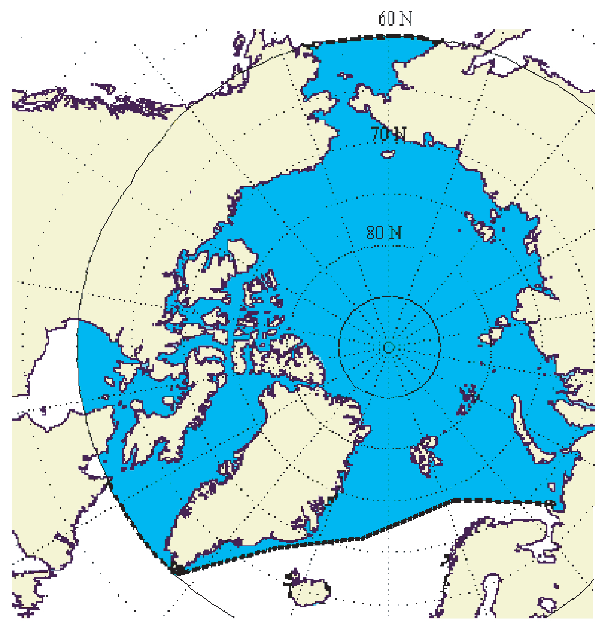For the purpose of these Guidelines, unless expressly provided
otherwise, the terms used have the meanings defined in the following
paragraphs. Additional definitions are given in the various chapters
as required. Terms used, but not defined in these Guidelines, are
to be interpreted as they are defined in the relevant Conventions.
G-3.1 "Administration" means the Government of
the State whose flag the ship is entitled to fly.
G-3.2 “Arctic ice-covered waters”
– solely for the purposes of these Guidelines, means those waters
which are both:
-
.1 located north of a line from the southern tip
of Greenland and thence by the southern shore of Greenland to Kape
Hoppe and thence by a rhumb line to latitude 67°03'9 N, longitude
026°33'4 W and thence by a rhumb line to Sørkapp, Jan Mayen
and by the southern shore of Jan Mayen to the Island of Bjørnøya,
and thence by a great circle line from the Island of Bjørnøya
to Cap Kanin Nos and thence by the northern shore of the Asian Continent
eastward to the Bering Strait and thence from the Bering Strait westward
to latitude 60° North as far as Il'pyrskiy and following the 60th North parallel eastward as far as and including Etolin Strait
and thence by the northern shore of the North American continent as
far south as latitude 60° North and thence eastward to the southern
tip of Greenland (see figure 1);
and
-
.2 in which sea ice concentrations of 1/10 coverage
or greater are present and which pose a structural risk to ships.
G-3.3 "COLREG" means the International Regulations
for Preventing Collisions at Sea, 1972, as amended.
G-3.4 "Company" means the owner of the ship or
any other organization or person such as the manager, or the bareboat
charterer, who has assumed the responsibility for operation of the
ship from the ship owner.
G-3.5 "Conning position" means the stations in
which the ship's control devices for ahead or astern operations are
located.
G-3.6 "Escort" means any ship with superior ice
capability in transit with another ship.
G-3.7 "Escorted operation" means any operation
in which a ship's movement is facilitated through the intervention
of an escort.
G-3.8 "Guidelines" means the IMO recommendatory
Guidelines for ships operating in Arctic ice-covered waters.
G-3.9 "IACS" means the International Association
of Classification Societies.
G-3.10 "Ice Navigator" means any individual who,
in addition to being qualified under the STCW
Convention, is specially trained and otherwise qualified to
direct the movement of a ship in ice-covered waters.
G-3.11 "Icebreaker" means any ship whose operational
profile may include escort or ice management functions, whose powering
and dimensions allow it to undertake aggressive operations in ice-covered
waters.
G-3.12 “International voyages” means
voyages in international waters, as defined in chapter
I of the SOLAS Convention.
G-3.13 "ISM Code" means the International Management
Code for the Safe Operation of Ships and for Pollution Prevention,
as amended.
G-3.14 "LL Convention" means
the International Convention on Load Lines, 1966, as amended.
G-3.16 "Organization" means the International
Maritime Organization.
G-3.17 "Polar Class" means the class assigned
to a ship based upon IACS Unified Requirements.
G-3.18 "Polar Class ship" means a ship for which
a Polar Class has been assigned.
G-3.19 "Pollutant" means the substances defined
as oil, oily mixture and oil fuel in Annex
I; noxious liquid substances in Annex
II; and solids when carried in bulk, which are also identified
as harmful substances in Annex III of
the MARPOL Convention.
G-3.20 "Port State" means a State whose area of
jurisdiction includes any destination port of a ship where such port
lies within Arctic ice-covered waters.
G-3.21 "Recognized organization" means an organization
recognized by an Administration in accordance with IMO resolutions
A.739(18) and A.789(19).
G-3.23 "SOLAS Convention"
means the International Convention for the Safety of Life at Sea,
1974, as amended.
G-3.24 "STCW Convention"
means the International Convention on Standards of Training, Certification
and Watchkeeping for Seafarers, 1978/1995, as amended.
G-3.25 "Unified Requirements" means the IACS Unified
Requirements for Polar Class shipsfootnote.
G-3.26 "WMO" means the World Meteorological Organization.
G-3.27 “Working liquid” means any
oil or oily substance used for the operation of the ship's machinery.

Figure 1 Maximum extent of application (see paragraph G-3.2.1)